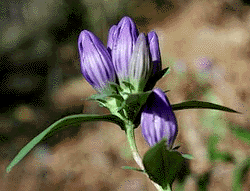
 The rich blue of gentians portend the end of the flowering season. From late September into November these bright blossoms develop, as leaves turn red and gold, then fall to cover the forest floor.
The rich blue of gentians portend the end of the flowering season. From late September into November these bright blossoms develop, as leaves turn red and gold, then fall to cover the forest floor.Gentians can be found in moist meadows, on wooded slopes and damp roadside ditches, in widely scattered localities. This beautiful plant is a long-lived perennial with terminal clusters of vivid blue to purplish flowers. The pointed lanceolate leaves are in pairs, opposite, entire and sessile. The corollas are tubular, closed at first and even at maturity seem closed.
Soapwort gentians are not difficult to grow as long as there is enough moisture. They grow from a crown with cordlike roots which spread in all directions. They need some sun and a fairly acid soil.
Prune roots to three to four inches but do not disturb soil around the roots. Space plants ten inches apart and set crowns one to one and one-half inches deep. Gentians need little care other than keeping them free of weeds. Fall is the best time for transplanting them.
